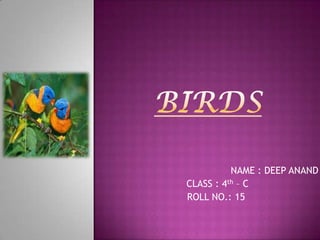Birds
•
50 recomendaciones•51,544 vistas
Denunciar
Compartir
Denunciar
Compartir

Recomendados
Recomendados
Más contenido relacionado
La actualidad más candente
La actualidad más candente (20)
Birds project - collection and identification of birds

Birds project - collection and identification of birds
Similar a Birds
Similar a Birds (20)
FLYING HIGH - ENVIRONMENTAL STUDIES CLASS III-CBSE

FLYING HIGH - ENVIRONMENTAL STUDIES CLASS III-CBSE
Give two examples of the life history traits of American Robin birds.pdf

Give two examples of the life history traits of American Robin birds.pdf
Más de Jyotsna Narang
Más de Jyotsna Narang (19)
Último
https://app.box.com/s/x7vf0j7xaxl2hlczxm3ny497y4yto33i80 ĐỀ THI THỬ TUYỂN SINH TIẾNG ANH VÀO 10 SỞ GD – ĐT THÀNH PHỐ HỒ CHÍ MINH NĂ...

80 ĐỀ THI THỬ TUYỂN SINH TIẾNG ANH VÀO 10 SỞ GD – ĐT THÀNH PHỐ HỒ CHÍ MINH NĂ...Nguyen Thanh Tu Collection
Último (20)
This PowerPoint helps students to consider the concept of infinity.

This PowerPoint helps students to consider the concept of infinity.
On National Teacher Day, meet the 2024-25 Kenan Fellows

On National Teacher Day, meet the 2024-25 Kenan Fellows
ICT role in 21st century education and it's challenges.

ICT role in 21st century education and it's challenges.
Fostering Friendships - Enhancing Social Bonds in the Classroom

Fostering Friendships - Enhancing Social Bonds in the Classroom
Food safety_Challenges food safety laboratories_.pdf

Food safety_Challenges food safety laboratories_.pdf
Micro-Scholarship, What it is, How can it help me.pdf

Micro-Scholarship, What it is, How can it help me.pdf
ICT Role in 21st Century Education & its Challenges.pptx

ICT Role in 21st Century Education & its Challenges.pptx
80 ĐỀ THI THỬ TUYỂN SINH TIẾNG ANH VÀO 10 SỞ GD – ĐT THÀNH PHỐ HỒ CHÍ MINH NĂ...

80 ĐỀ THI THỬ TUYỂN SINH TIẾNG ANH VÀO 10 SỞ GD – ĐT THÀNH PHỐ HỒ CHÍ MINH NĂ...
Exploring_the_Narrative_Style_of_Amitav_Ghoshs_Gun_Island.pptx

Exploring_the_Narrative_Style_of_Amitav_Ghoshs_Gun_Island.pptx
Birds
- 1. NAME : DEEP ANAND CLASS : 4th – C ROLL NO.: 15
- 2. INTRODUCTION BEAKS AND THEIR DIFFERENT TYPES FEET AND CLAWS
- 3. Birds live at different places according to their needs and body features. They have wings and most of them can fly. They have light hollow bones and strong muscles. All the birds have two feet and a beak. Their feet have claws.
- 4. Birds do not have any teeth, Therefore, beak is used to tear, bite, chisel or crush the food. The shape of the beak is according to the food habit of the bird. Some birds use their beaks to fight with the enemy or catch the prey or use it for preening their feathers.
- 6. Birds like sparrow and pigeon have short and hard beak. They use it for crushing seeds and grains to make it soft before eating. Sparrow Pigeon
- 7. Birds like parrot have curved beak for cracking nuts and fruits.
- 8. Some birds like eagle and vulture eat flesh. Such birds have strong, hard and curved beak for tearing the flesh. Eagle Vulture
- 9. Birds like wood pecker have strong, long and straight beak to peck at the wood and eat insects present in the wood.
- 10. Some birds like sunbird and hooper have long and slender beak. Sunbird sucks nectar from flowers while hooper takes out insects and worms from the holes in the ground. Sunbird Hooper
- 11. The duck has a flat and broad beak which has small holes on both sides. Its beak pushes out mud and water from the holes leaving the food behind. It can sift food from mud and water.
- 12. A Swallow has a small and broad beak. It catches flies while flying. The beak is sticky from inside.
- 13. Claws of birds are shaped to suit their perching and food habits. Claws can be used for climbing, protecting, holding food, swimming and perching.
- 14. Eagle, vulture and hawk have strong and sharp claws to firmly hold the prey while flying. Eagle Hawk Vulture
- 15. Sparrows have long and slender claws with three toes in front and one at the back. They are used to firmly hold a branch or a wire.
- 16. Ducks and penguins have webbed feet to swim. They are good swimmers but they walk slowly.
- 17. Crane and jacana have long legs and wide spreading toes. These help them to walk in shallow water or mud. They can walk in the mud without getting their body wet.
- 18. Some birds like hen have strong feet with three toes in front and one at the back. Each toe has a sharp claw to scratch the ground in search of seeds and insects present in the soil.
- 19. Birds like wood pecker and parrot have two toes pointing upwards and two downwards. These birds can cling to the trees to catch the insects and hold the fruits.